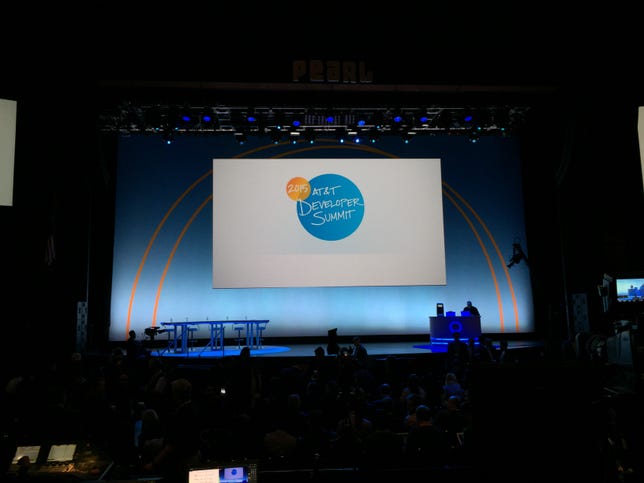LAS VEGAS — AT&T had a lot to share at its developer conference, including new partners for its smart home and connected car programs and a panel discussing the Internet of Things.

Roger Cheng/CNET
Oh, and the company quietly slipped in an announcement that it will carry LG’s G Flex 2.
The focus of AT&T’s annual developer summit, held a day before International CES officially kicks off, underscores the broader shifts going on within the company. While AT&T’s core business remains Internet, landline and wireless phone service, it’s branching out into different areas, such as connecting cars and homes.
“They’re not little platforms,” Ralph de la Vega, CEO of the company’s business and mobile division, said at the event. “They’re national platforms we’re excited about.”
It’s clear why AT&T, the nation’s second-largest wireless company by subscribers, is making such a shift. The business of selling wireless smartphone services is getting tougher. T-Mobile is outstripping its rivals in customer growth and Sprint is showing signs of life after becoming a disruptive competitor again. And as more people buy smartphones, it’s getting tougher for carriers to add subscribers — prompting them to offer more promotions.
“AT&T is the carrier most focused on what’s next,” said Jan Dawson, an analyst at Jackdaw Research.
If AT&T wants to keep the growth engine humming, it needs to find new sources of fuel.
AT&T has made several bets that are beginning to pay off. One is on the business of connected cars. A year ago, the company unveiled its AT&T Drive platform that helps automakers add connected car services, such as entertainment or diagnostic capabilities. It later opened a facility, Drive Studio, to get automakers testing out different services.
This year, AT&T said Samsung would serve as a major partner and sponsor to AT&T Drive. It also added developer support from the likes of Glympse and Audiobooks.com. The carrier also said Subaru of America would add a 4G LTE connection to select 2016 vehicles, making Subaru the latest in a long line of car companies to work with AT&T.
The home is equally important to AT&T. Hoping to build upon its home Internet and phone services, the company in 2013 launched a home security and automation business called Digital Life. The service, available in 85 markets, is still expanding and competes against traditional security companies and cable providers, many of which also offer smart home features.
AT&T said its platform would support Samsung, LG, Lutron Electronics, and Qualcomm Life’s biometric and health reading technology, giving consumers more options for customizing their smart home through AT&T. Unlike Nest or Apple’s Homekit, AT&T delivers Digital Life as a service with a monthly fee, just as it would Internet or wireless service.
With the home, connected car and other items such as connected pill bottles or dog collars, AT&T sees an opportunity to provide a cellular radio to anything, embracing the concept known as “Internet of Things,” in which everything is online and talking to each other. It’s an area of intense interest for the tech industry. The market is expected to be worth $3.04 trillion by 2020, up from $1.3 trillion in 2013, according to market research firm IDC.
The topic was important enough to warrant a panel, featuring — among others — Qualcomm CEO Steve Mollenkopf and Cisco Chief Technology Officer Padmasree Warrior.
“No matter what forecast you see, they’re big,” said AT&T Mobility CEO Glenn Lurie.
AT&T also unveiled its M2X Data Service, a managed service and set of design tools for developers looking to create IoT products and services.
While T-Mobile remains the flashiest carrier with new ways to convince customers to switch to its service, AT&T has been smart about looking at what’s ahead, Dawson said.
“AT&T figured it out several years ago: There’s only so many people in the US using phones,” Dawson said. “As a result, it established a lead over the other carriers.”
AT&T’s only smartphone announcement was its intent to carry the LG G Flex 2, which was unveiled earlier Monday by LG at its CES presentation. The news came via a press release sent moments before AT&T’s developer conference kicked off.



